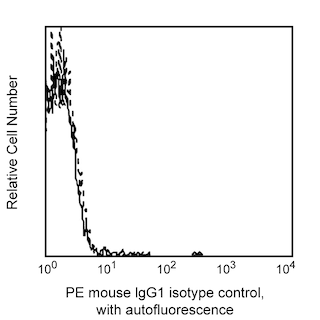-
Your selected country is
Middle East / Africa
- Change country/language
Old Browser
This page has been recently translated and is available in French now.
Looks like you're visiting us from {countryName}.
Would you like to stay on the current country site or be switched to your country?


.png)

Analysis of CD144 on Human Umbilical Vein Endothelial Cells (HUVECs). HUVECs were stained with either PE Mouse Anti-Human CD144 (solid line) or PE Mouse IgG1, κ Isotype Control (clone MOPC-21, Cat. No. 555749, dotted line). Flow cytometry was performed on a BD LSR™ II flow cytometry system.
.png)

BD Pharmingen™ PE Mouse anti-Human CD144
.png)
Regulatory Status Legend
Any use of products other than the permitted use without the express written authorization of Becton, Dickinson and Company is strictly prohibited.
Preparation And Storage
Product Notices
- This reagent has been pre-diluted for use at the recommended Volume per Test. We typically use 1 × 10^6 cells in a 100-µl experimental sample (a test).
- An isotype control should be used at the same concentration as the antibody of interest.
- Source of all serum proteins is from USDA inspected abattoirs located in the United States.
- Caution: Sodium azide yields highly toxic hydrazoic acid under acidic conditions. Dilute azide compounds in running water before discarding to avoid accumulation of potentially explosive deposits in plumbing.
- For fluorochrome spectra and suitable instrument settings, please refer to our Multicolor Flow Cytometry web page at www.bdbiosciences.com/colors.
- Please refer to www.bdbiosciences.com/us/s/resources for technical protocols.
The 55-7H1 antibody monoclonal antibody specifically binds to a calcium-independent epitope on Cadherin-5, a member of the cadherin family of calcium-dependent adhesion molecules. Cadherin-5 is also known as CD144 or VE-Cadherin. CD144 is expressed on endothelial cells in vivo and in vitro. It may play a role in the organization of lateral endothelial junctions and in the control of permeability properties of vascular endothelium.

Development References (3)
-
Breier G, Breviario F, Caveda L, et al. Molecular cloning and expression of murine vascular endothelial-cadherin in early stage development of cardiovascular system.. Blood. 1996; 87(2):630-41. (Biology). View Reference
-
Lampugnani MG, Resnati M, Raiteri M, et al. A novel endothelial-specific membrane protein is a marker of cell-cell contacts.. J Cell Biol. 1992; 118(6):1511-22. (Biology). View Reference
-
Vincent PA, Xiao K, Buckley KM, Kowalczyk AP. VE-cadherin: adhesion at arm's length.. Am J Physiol, Cell Physiol. 2004; 286(5):C987-97. (Biology). View Reference
Please refer to Support Documents for Quality Certificates
Global - Refer to manufacturer's instructions for use and related User Manuals and Technical data sheets before using this products as described
Comparisons, where applicable, are made against older BD Technology, manual methods or are general performance claims. Comparisons are not made against non-BD technologies, unless otherwise noted.
For Research Use Only. Not for use in diagnostic or therapeutic procedures.
Report a Site Issue
This form is intended to help us improve our website experience. For other support, please visit our Contact Us page.
